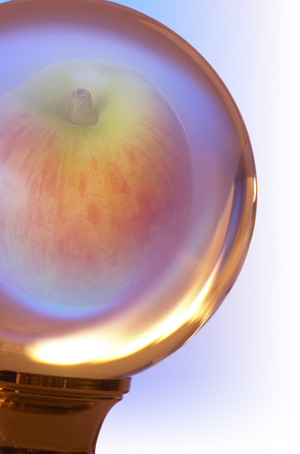
Features
Production
Research
B.C.’s Golden Apple winner considers the future
considerd the future
March 15, 2008 By Peter Mitham
Steady investments in new trees
and new varieties, not to mention time, won a Kelowna orchardist top
honours from the British Columbia fruit industry.
 Steady investments in new trees and new varieties, not to mention time, won a Kelowna orchardist top honours from the British Columbia fruit industry.
Steady investments in new trees and new varieties, not to mention time, won a Kelowna orchardist top honours from the British Columbia fruit industry.
Tarlok Singh received the annual Golden Apple award from the B.C. Fruit Growers’ Association during the association’s annual horticultural forum in Penticton on November 15.
Singh has been an orchardist for eight years, growing apples part-time in addition to his work as a machinist in a Kelowna fabricating shop.
He was singled out by a panel of three judges for his exemplary orchard management, high yields and the quality of his fruit.
Since acquiring his 20-acre orchard in 1998 with a view to developing it as a retirement venture, Singh has taken advantage of the provincially funded orchard replant program to remove older, standard-size trees with high-density plantings of new varieties. He expects to complete the renovation of the orchard in spring 2007.
Singh’s orchard originally had McIntosh, Spartan, Red Delicious and Golden Delicious. He pulled out the Red Delicious and McIntosh trees first, replacing them with Royal Galas and Ambrosias. Honeycrisps
followed.
But he also planted some of the time-honoured Spartan varieties in high-density arrangements, as well as Golden Smoothie, a more recent cultivar of the Golden Delicious that he says has a more appealing appearance.
Careful management of the new plantings has allowed him to exceed standard yields.
“From one acre this year, I had 76 bins,” Singh said.
With 800 pounds to a bin, that works out to more than 60,750 pounds of apples from that one acre, compared to an average of 60 to 65 bins in many other renovated orchards. A traditional orchard with standard trees typically produces just 40 bins an acre.
Singh was among those most surprised by the yield, but he points to lessons learned growing up in India and attentive management as well as the greater density of the plantings for the jump in productivity.
“You’ve got to put in to get out,” he said, explaining the lessons learned from parents who raised vegetables, grain and sugar cane.
His early experiences taught him to pay close attention to the growing conditions in his Okanagan orchard, from ensuring a clean orchard floor with a minimum of weeds to appropriate irrigation methods and regular spraying. Skimping on management is not something Singh recommends.
“I do whatever I can to keep up with the work and produce better,” he said. “Sometimes, some farmers, they’ll think, ‘Oh, there’s not much money in there, so don’t put more money into that’ – (they) just save a little bit here and there. That will affect the production and the orchard. But then the trees will get weak, and they don’t produce much and they don’t produce quality. But if you want to produce quality and quantity, you’ve got to take care of the trees first.”
Still, Singh knows that even the best management doesn’t guarantee a financial reward, even though it’s good for the long-term health of the orchard.
In 2002, for example, returns from his orchard didn’t even cover his labour costs, let alone sprays, fertilizer and other inputs. Replanting and a gradual strengthening of prices has helped him stay afloat in the years since, he said, but he’s cautious about the future.
An orchard his size isn’t enough to weather the shocks of poor weather and low prices and, at 65, Singh isn’t sure he’s ready to face the stresses of apple-growing well into his retirement.
Singh muses that in two to three years, when his orchard is approaching full production, he may be able to make a go of it financially, but he isn’t sure he’ll want to be farming at that point. Without kids willing to take over the orchard, he’s thinking about selling.
But making a go of the business will require more than the yields Singh is seeing. Prices, which were low enough that packing houses sent bills rather than cheques to some growers two years ago, will also have to recover.
“Price makes more difference than quantity,” Singh said.¶
Print this page